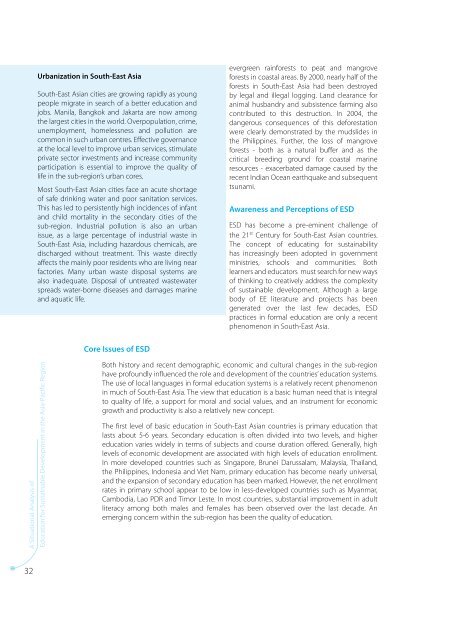A Situational Analysis - UNESCO Bangkok
A Situational Analysis - UNESCO Bangkok
A Situational Analysis - UNESCO Bangkok
You also want an ePaper? Increase the reach of your titles
YUMPU automatically turns print PDFs into web optimized ePapers that Google loves.
Urbanization in South-East Asia<br />
South-East Asian cities are growing rapidly as young<br />
people migrate in search of a better education and<br />
jobs. Manila, <strong>Bangkok</strong> and Jakarta are now among<br />
the largest cities in the world. Overpopulation, crime,<br />
unemployment, homelessness and pollution are<br />
common in such urban centres. Effective governance<br />
at the local level to improve urban services, stimulate<br />
private sector investments and increase community<br />
participation is essential to improve the quality of<br />
life in the sub-region’s urban cores.<br />
Most South-East Asian cities face an acute shortage<br />
of safe drinking water and poor sanitation services.<br />
This has led to persistently high incidences of infant<br />
and child mortality in the secondary cities of the<br />
sub-region. Industrial pollution is also an urban<br />
issue, as a large percentage of industrial waste in<br />
South-East Asia, including hazardous chemicals, are<br />
discharged without treatment. This waste directly<br />
affects the mainly poor residents who are living near<br />
factories. Many urban waste disposal systems are<br />
also inadequate. Disposal of untreated wastewater<br />
spreads water-borne diseases and damages marine<br />
and aquatic life.<br />
evergreen rainforests to peat and mangrove<br />
forests in coastal areas. By 2000, nearly half of the<br />
forests in South-East Asia had been destroyed<br />
by legal and illegal logging. Land clearance for<br />
animal husbandry and subsistence farming also<br />
contributed to this destruction. In 2004, the<br />
dangerous consequences of this deforestation<br />
were clearly demonstrated by the mudslides in<br />
the Philippines. Further, the loss of mangrove<br />
forests - both as a natural buffer and as the<br />
critical breeding ground for coastal marine<br />
resources - exacerbated damage caused by the<br />
recent Indian Ocean earthquake and subsequent<br />
tsunami.<br />
Awareness and Perceptions of ESD<br />
ESD has become a pre-eminent challenge of<br />
the 21 st Century for South-East Asian countries.<br />
The concept of educating for sustainability<br />
has increasingly been adopted in government<br />
ministries, schools and communities. Both<br />
learners and educators must search for new ways<br />
of thinking to creatively address the complexity<br />
of sustainable development. Although a large<br />
body of EE literature and projects has been<br />
generated over the last few decades, ESD<br />
practices in formal education are only a recent<br />
phenomenon in South-East Asia.<br />
Core Issues of ESD<br />
<br />
<br />
Both history and recent demographic, economic and cultural changes in the sub-region<br />
have profoundly influenced the role and development of the countries’ education systems.<br />
The use of local languages in formal education systems is a relatively recent phenomenon<br />
in much of South-East Asia. The view that education is a basic human need that is integral<br />
to quality of life, a support for moral and social values, and an instrument for economic<br />
growth and productivity is also a relatively new concept.<br />
The first level of basic education in South-East Asian countries is primary education that<br />
lasts about 5-6 years. Secondary education is often divided into two levels, and higher<br />
education varies widely in terms of subjects and course duration offered. Generally, high<br />
levels of economic development are associated with high levels of education enrollment.<br />
In more developed countries such as Singapore, Brunei Darussalam, Malaysia, Thailand,<br />
the Philippines, Indonesia and Viet Nam, primary education has become nearly universal,<br />
and the expansion of secondary education has been marked. However, the net enrollment<br />
rates in primary school appear to be low in less-developed countries such as Myanmar,<br />
Cambodia, Lao PDR and Timor Leste. In most countries, substantial improvement in adult<br />
literacy among both males and females has been observed over the last decade. An<br />
emerging concern within the sub-region has been the quality of education.<br />
32

















